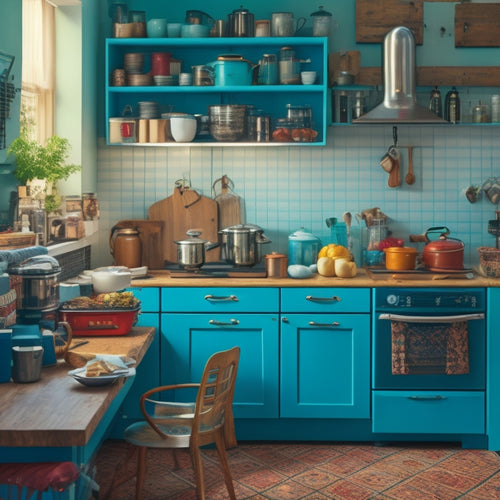
3 Essential Steps to a Clutter-Free Kitchen
Share
You'll reach a clutter-free kitchen by following three essential steps. First, purge and declutter by gathering items into categories, being ruthless about unused items, and donating or selling excess goods. Next, organize your kitchen spaces efficiently by zoning areas, utilizing vertical space, and assigning spots for each essential item. Finally, maintain clutter-free habits by incorporating daily tasks, practicing mindful shopping, and sticking to your shopping list. With these steps, you'll be well on your way to a kitchen that's both functional and peaceful - and there's even more you can do to optimize your new space.
Key Takeaways
• Purge and declutter kitchen items by sorting into keep, donate/sell, and discard boxes, being ruthless about unused items.
• Efficiently organize kitchen spaces by zoning, utilizing vertical space, and designating a spot for each essential item.
• Practice mindful shopping by assessing needs, checking space, and avoiding impulse buys to maintain a clutter-free kitchen.
Purge and Declutter Kitchen Items
Start by gathering three boxes or bins labeled 'keep,' 'donate/sell,' and 'discard' to categorize the items you'll be purging from your kitchen. This simple step will help you stay focused and guarantee that you're making intentional decisions about what stays and what goes.
Next, sort through your kitchen items, starting with the easiest decisions first. Be ruthless – if you haven't used it in the past year, it's probably safe to get rid of it. Donate excess kitchen gadgets, dishes, or cookbooks that are still in good condition. Consider hosting a garage sale or selling items online to make some extra cash.
As you sort, ask yourself if each item is truly necessary or if it's just taking up valuable space. Be honest with yourself – if you haven't used it, you probably won't miss it. By purging your kitchen of unnecessary items, you'll be left with a more streamlined, efficient space that sparks joy and inspires cooking.
Organize Kitchen Spaces Efficiently
With a clutter-free kitchen inventory, you can now focus on allocating space efficiently, assigning a designated spot for each essential item to create a harmonious workflow. This is where you maximize storage and optimize layout to make the most of your kitchen's real estate.
To achieve this, consider the following:
-
Zone your kitchen: Divide your kitchen into zones, such as cooking, prep, and storage. This will help you allocate space and assign tasks efficiently.
-
Utilize vertical space: Install shelves, hooks, or a pegboard to maximize storage and keep frequently used items within easy reach.
-
Designate a 'landing strip': Allocate a specific area, like a countertop or a tray near the entrance, as a 'landing strip' for keys, mail, and other essentials that tend to clutter your kitchen.
Maintain Clutter-Free Kitchen Habits
Your newly organized kitchen requires consistent habits to maintain its clutter-free status, so establish routines that promote cleanliness and efficiency. Start by incorporating daily maintenance into your routine. This means wiping down countertops after meals, putting away dishes immediately, and sweeping the floor regularly. These small tasks will prevent clutter from building up and make cleaning easier.
Another essential habit to adopt is mindful shopping. Before buying any kitchen items, ask yourself if you really need them and if you have space for them. Avoid impulse purchases, and stick to your shopping list.
When you bring new items into your kitchen, get rid of old or duplicate items to maintain a balanced amount of possessions.
Frequently Asked Questions
How Do I Handle Cluttered Kitchen Items Inherited From Family Members?
When dealing with sentimental items inherited from family members, you're torn between keeping them for nostalgia and decluttering for sanity; prioritize organization by categorizing family heirlooms, then decide what to keep, display, or respectfully let go of.
Can a Clutter-Free Kitchen Coexist With a Busy Family Lifestyle?
You can maintain a clutter-free kitchen amidst a busy family lifestyle by mastering time management and organization, simplifying routines, and prioritizing space to create a functional haven that fuels your family's active pace.
Are There Any Eco-Friendly Ways to Dispose of Old Kitchen Items?
When you're ready to bid farewell to old kitchen items, consider sustainable recycling, upcycling, or donating them to reduce waste, or composting food scraps to create nutrient-rich soil, giving your old items a new, eco-friendly purpose.
How Often Should I Reassess My Kitchen's Organization and Decluttering?
You should reassess your kitchen's organization and decluttering regularly, ideally every 3-6 months, to maintain a balance between functionality and aesthetics, and schedule decluttering sessions to stay on top of clutter and keep your space organized.
Can a Small Kitchen Still Be Functional and Clutter-Free?
You might be surprised to know that 68% of homeowners consider their kitchen to be the heart of their home! Yes, a small kitchen can still be functional and clutter-free by incorporating space-saving solutions, minimalist design, creative storage, and dual-purpose items that maximize every inch.
Related Posts
-

Why Renters Need Creative Kitchen Storage Solutions
You're likely no stranger to the frustrating reality of limited kitchen storage, where every inch counts and clutter ...
